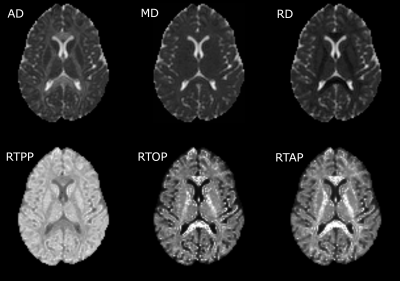Álvaro Planchuelo-Gómez1, Rodrigo de Luis-García1, Antonio Tristán-Vega1, David García-Azorín2, Ángel Luis Guerrero2, and Santiago Aja-Fernández1
1Imaging Processing Laboratory, Universidad de Valladolid, Valladolid, Spain, 2Headache Unit, Hospital Clínico Universitario de Valladolid, Valladolid, Spain
1Imaging Processing Laboratory, Universidad de Valladolid, Valladolid, Spain, 2Headache Unit, Hospital Clínico Universitario de Valladolid, Valladolid, Spain
Advanced diffusion measures calculated with AMURA
detect changes in migraine patients compared to controls that are not detected
by traditional DTI measures. AMURA can give complementary information to
DTI-based studies even with low b-values.

Figure 4. Summary of the results obtained in the
diverse analyses. Significant differences between episodic
migraine (EM) and controls were found only with the AMURA return-to-origin
probability (RTOP), detecting white matter alterations non-measurable with Diffusion Tensor Imaging (DTI). Differences between chronic migraine (CM) and EM were found
with return-to-plane probability (RTPP) obtained with AMURA and axial
diffusivity (AD) from DTI. No differences were found
between CM and controls.

Figure 5. Visual comparison of Diffusion Tensor
Imaging (DTI) and Apparent Measures Using Reduced Acquisitions (AMURA). The first row contains the DTI measures, from left
to right: axial (AD), mean (MD) and radial diffusivity (RD). The second row
contains AMURA metrics, from left to right: return-to-plane (RTPP),
return-to-origin (RTOP) and return-to-axis probability (RTAP).
